Monday Pelicans
Double-click on any image to view it full size. Click the back-button to return to your place on this page.
Greetings!
First of all, to all of you who suggested that last week’s mystery picture was of a mushroom – congratulations!
It’s been many weeks now since Ruthi and I have been to the beach – things keep cropping up. One of the things I miss most is watching the pelicans. So this essay is devoted to pelicans. I have mentioned them in some previous essays, but this essay features almost totally hitherto-unused images. Virtually all the pelicans we see in North Carolina are Brown Pelicans (Pelecanus occidentalis), which, with a wingspan of only about 7 feet, are the smaller of the two pelican species found in North America. Described in some sources as “comically elegant”, I hope picture #1 captures the elegance!
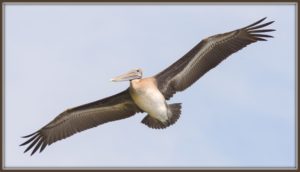
Pelicans can fly up to ninety-three miles per day to and from their feeding grounds, often in long single lines, but sometimes in a “V” formation. Picture #2 shows 49 (as best as I can count) individuals in a loose line flying along “our” beach. (Our cottage is not quite visible, but is just to the right of the red roof on the extreme right of the picture).

It has been shown that by flying in just the right relationship to each other, pelicans (and other birds) can take advantage of the upward rotational component of the wingtip vortex of the bird in front, and save energy. It is also clear that pelicans have learned to take advantage of airflow deflected upwards by sand dunes, houses, or even waves, and can soar significant distances without having to flap their wings. They can also reportedly reach altitudes of ten thousand feet by using thermal updrafts! Having reached their feeding grounds, they typically dive headfirst from up to sixty feet into the water. Picture #3 shows a number of pelicans in various stages of the dive (and subsequently floating on the surface), along with some seagulls.
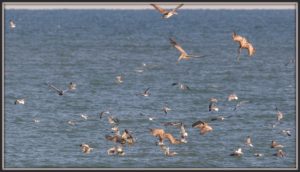
Pelicans also like to perch on man-made structures that project into the water. I find it fascinating to watch their approach pattern to a dilapidated pier near our cottage. They seem to fly a pattern amazingly similar to the classic approach pattern of a powered aircraft, with the final segment being into wind with landing gear extended (picture #4).
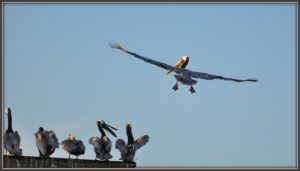
At least one of the observers in this pictures appears to be offering a critique of the approach execution to its neighbor! #5 shows another approach at the moment just before touchdown when the airflow over the bird’s wing has completely broken down, as evidenced by the feathers on the upper surface of the wings blowing in all directions.

Of course, one of the best known features of the pelican is the large pouch below its beak, in which it can gather water and fish. #6 shows the pouch quite nicely, with the backlighting showing that the skin is actually translucent.

If you are not familiar with the limerick about the capacity of the pouch, you can find it at http://countryroadsmagazine.com/outdoors/knowing-nature/a-wonderful-bird-is-the-pelican/ , which was one of the sources I used for the facts in this essay. Picture #3 showed pelicans mixed in with seagulls, which is quite common. Somewhat less easy to see is a behavior in which a seagull will actually wait until it can grab a fish from the beak of a pelican, even going so far as standing on the pelican’s head, as in #7.

I have watched this behavior several times, and the pelicans concerned did not seem to be bothered by it!
I have already commented on the way that pelicans will fly just above the water, seeming to benefit from the upflow of air over the waves. #8 shows a bird doing this with its right hand wingtip just millimeters from the water, as shown by the proximity of the shadow to the wing. In fact, a split second before this image, the wing tip had just dragged the surface, and the splash can be seem just behind the wingtip.
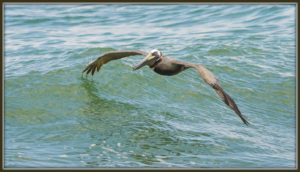
I am almost convinced that the pelicans actually enjoy doing this! Most of the time the birds will gain a few feet of altitude while the wave actually breaks (#9), and then drop down to the face of the next wave.
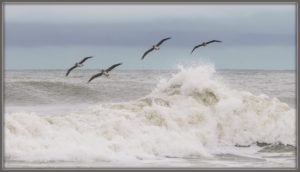
The other North American pelican is the White Pelican (Pelecanus erythrorhynchos). I have only seen these birds once in North Carolina, and then only while they were flying overhead (#10). (This is the only picture in this set that has also appeared in a previous essay.) White Pelicans have a wingspan of up to ten feet.

I close this set with another “portrait” (#11).

Have a good Labor Day, and a great week!